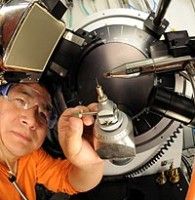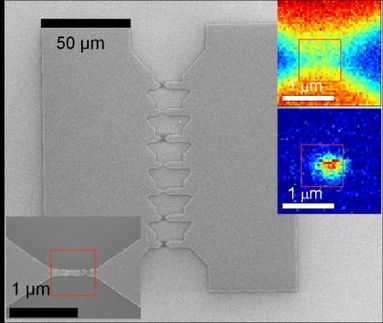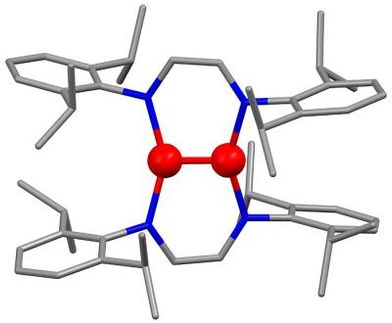Compound could help detect chemical, biological weapons
Advanced Photon Source only place in U.S. to examine such small crystals
Advertisement
A light-transmitting compound that could one day be used in high-efficiency fiber optics and sensors that detect biological and chemical weapons at long distance almost went undiscovered by scientists because its structure was too difficult to examine.

Scientist Yu-Sheng Chen calibrates the needle of the X-ray diffraction machine at ChemMatCARS in the Advanced Photon Source. The beamline is the only place in the U.S. able to examine the small crystals of compound that may be able to identify biological and chemical weapons.
DOE/Argonne National Laboratory
Luckily, scientists from U.S. Department of Energy's Argonne National Laboratory and Northwestern University were able to determine the structure of the compound using the uniquely suited Chemistry and Materials (ChemMatCARS) beamline of the Center for Advanced Radiation Sources at the Advanced Photon Source.
"Like other such materials, this material has an electrically polarized structure," said Argonne scientist Mercouri Kanatzidis. "The incident light interacts with the electron cloud and in the process is disturbed. The disturbance changes the wavelength of the emitted light and creates two beams: the original and the second harmonic - a beam with half the wavelength and double the frequency."
This second-harmonic beam is 15 times more intense than that produced by the best current material. This two-for-one wavelength boost is paired with greater transparency, so the material can actually transmit the whole higher-wavelength beam.
These properties could have eventual real-world applications in identifying biological and chemical weapons at long distances and in optical communications.
However, these properties almost went undiscovered. The material, (A)ZrPSe 6, where A can be potassium, rubidium or cesium, has a unique and difficult chemical structure that does not crystallize well. It grows lengthwise, but not in other directions. This creates long, thin crystals--perfect for fiber optics but a headache to study by conventional means.
"They are not very easy to design or make," Kanatzidis said. "It doesn't like to grow in other directions."
Finally, using the ChemMatCARS at the APS, Kanatzidis, Santanu Banerjee, Christos Malliakas, Joon I Jang, and John B. Ketterson were able to determine the structure and analyze its remarkable properties.
ChemMatCARS specializes in X-ray diffraction from ultra-small crystals and is operated by the University of Chicago.
Original publication: J. Am. Chem. Soc. 2008, 37, 12270-12272.
Other news from the department science
These products might interest you
Most read news
More news from our other portals
See the theme worlds for related content
Topic world Sensor technology
Sensor technology has revolutionized the chemical industry by providing accurate, timely and reliable data across a wide range of processes. From monitoring critical parameters in production lines to early detection of potential malfunctions or hazards, sensors are the silent sentinels that ensure quality, efficiency and safety.

Topic world Sensor technology
Sensor technology has revolutionized the chemical industry by providing accurate, timely and reliable data across a wide range of processes. From monitoring critical parameters in production lines to early detection of potential malfunctions or hazards, sensors are the silent sentinels that ensure quality, efficiency and safety.


































































